We tailor retinoblastoma treatment for each case based on many factors.
These can include:
- The child's age
- Their health
- Medical history
- Cancer stage
- Tolerance for certain medications and therapies.
Chemotherapy for Retinoblastoma
Chemotherapy is a medicine that kills fast-growing cells, including cancer cells. There are a few ways that your doctor may suggest chemotherapy for retinoblastoma, including systemic chemotherapy and local chemotherapy directly into the eye.
There are two ways doctors use local chemotherapy in the eye:
- Intra-vitreal: The doctors inject medicine directly into the vitreous gel in the back of the eye. It can be a good option for small clumps of cancer cells that stick around or come back in this fluid. It delivers the medicine directly to the tumor and reduces exposure to the rest of the body.
- Intra-arterial: The doctors inject medicine into the artery that supplies blood to the eye (ophthalmic artery). It's an option for tumors in just one eye and those that come back after other treatments. The chemotherapy enters just the eye, increasing its potency. We repeat the procedure every 4 weeks for up to 6 cycles.
Radiation for Retinoblastoma
Radiation treatment for retinoblastoma may include standard radiation or brachytherapy. In brachytherapy, doctors place a source of radiation very close to the tumor for a short time. In the eye, doctors stitch a gold plaque (disc) with radioactive seeds onto the eye's surface.
The radiation plaque is custom-made to fit the eye and the tumor. It stays in place for three to five days. During that time, your child will wear a heavy patch and lead shield on their eye to protect from radiation exposure.
Other Procedures for Retinoblastoma
We sometimes use laser photocoagulation to destroy cancer cells. We use it alone for smaller tumors or use it with chemotherapy for larger tumors. It causes minimal discomfort.
We also use a frozen metal probe, called cryotherapy, to damage cancer cells. We use it for smaller tumors toward the edge of the retina. We might use it if laser treatment is not effective. It can cause mild redness, swelling and discomfort for a few days.
If retinoblastoma isn't responding to treatment, we may need to remove the eye, so the cancer doesn't spread to other parts of the body. Doctors will do surgery to remove the eye. About six to ten weeks after surgery, we will fit your child with an artificial eye called an ocular prosthesis.
Losing an eye and getting a prosthetic can be emotionally traumatic. Our team, which includes a child life specialist, will work with you to identify support resources, including support groups that may help your family cope during the adjustment period.
Screening and Genetic Testing for Retinoblastoma
Doctors can test for hereditary retinoblastoma, a gene change that raises the risk of cancers. These kids can get retinoblastoma, but they also have a higher risk of developing bone cancer, skin cancer or types of brain cancer.
Doctors can check for the gene before or at birth If they are at risk of having it.
- Preimplantation: Embryos tested during in vitro fertilization (IVF). Your doctor will only transfer unaffected embryos to the uterus.
- Early pregnancy: We can test fetal cells from amniocentesis or chorionic villus biopsy. Our expert team can offer effective care before the baby is born.
We see kids with a family history of retinoblastoma at the Cancer Predisposition Clinic. We see Adults with a personal or family history at the Hereditary Cancer Risk Clinic.
Early detection lets us treat this rare eye cancer at a very early stage. The sooner we detect retinoblastoma, the better the outcome. We can test for eye tumors in late pregnancy, around 32 weeks, using ultrasound and MRI. It helps us create a care plan for when the baby is born.
We use optical coherence tomography for newborns and older kids at risk of retinoblastoma. It takes special pictures of the back of the eye by imaging each layer of the retina. This tool can find tumors too small to see on other tests.





